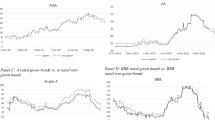Abstract
The study analyzes the causal relationship between macroeconomic indicators and sovereign bond indices of India and China. The main purpose of this research study is to answer the question how sovereign yields of bond indices in India and China reflects economic conditions and if sovereign bond market of India and China are informationally efficient. Toda and Yamamoto (J Econom 66:225–250, 1995) approach is used for testing Granger causality. Bivariate analysis is performed on monthly data from January 2000 to December 2016, and four macroeconomic indicators are examined such as interest rate, exchange rate, gross domestic product and fiscal deficit. Analysis applies unit root test to check maximal order of integration, VAR lag order selection criteria to check maximum lag order and Wald test for linear restrictions to examine Granger causality.
Similar content being viewed by others
References
Bachelier L (1900) Théorie de la spéculation. Gauthier-Villars. Annales Scientifiques de l’Ecole Normale Superieure Ser 3(17):21–86
Bajaj M, Vijh A (1990) Dividend clienteles and the information content of dividend changes. J Financial Econ 26:193–219
Bernard V, Thomas J (1989) Post-earnings-announcement drift: delayed price response or risk premium? J Account Res 27:1–36
Black F, Scholes M (1974) The effects of dividend yield and dividend policy on common stock prices and returns. J Financial Econ 1(1):1–22
Brown SJ, Goetzmann WN (1995) Performance persistence. J Finance 50(2):679–698
Campbell JY, Shiller RJ (1988) The dividend-price ratio and expectations of future dividends and discount factors. Rev Financial Stud 1(3):195–228
Cargill TF (1975) The term structure of interest rates: a test of the expectations hypothesis. J Finance 30(3):761–771
Chopra N, Lakonishok J, Ritter JR (1992) Measuring abnormal performance: Do stocks overreact? J Financial Econ 31(2):235–268
Copeland T (1979) Liquidity changes following stock splits. J Finance 34:115–141
Cowles A, Jone HE (1937) Some posterior probabilities in stock market action. Econometrica 5(3):280–294
Dicle MF, Beyhan A, Yao LJ (2010) Market efficiency and international diversification: evidence from India. Int Rev Econ Finance 19(2):313–339
Dogan TT, Aksoy E (2014) Is equity market efficient? Evidence from a small open economy. Int Bus Res 7(10):88
Elton EJ, Gruber MJ, Das S, Hlavka M (1993) Efficiency with costly information: a reinterpretation of evidence from managed portfolios. Rev Financ Stud 6(1):1–22
Fama E (1970) Efficient capital markets: a review of theory and empirical work. J Finance 25:383–417
Fama E (1991) Efficient capital markets II. J Finance 46:1575–1617
Fama EF, Fisher L, Jensen MC, Roll R (1969) The adjustment of stock prices to new information. Int Econ Rev 10(1):1–21
Goetzmannn W, Ibbotson R (1994) Do winners repeat? Patterns in mutual fund performance. J Portf Manag 9–18
Hamburger MJ, Platt EN (1975) The expectations hypothesis and the efficiency of the treasury bill market. Rev Econ Stat 57:190–199
Holthausen R, Leftwich R, Mayers D (1987) The effect of large block transactions on security prices: a cross-sectional analysis. J Financ Econ 19:237–267
Ikoku AE (2010) Is the stock market a leading indicator of economic activity in Nigeria? CBN J Appl Stat 1(1):17–38
Jegadeesh N, Titman S (1993) Returns to buying winners and selling losers: implications for stock market efficiency. J Finance 48(1):65–91
Joyeux R, Milunovich G (2010) Testing market efficiency in the EU carbon futures market. Appl Financ Econ 20(10):803–809
Kraus A, Stoll HR (1972) Price impacts of block trading on the New York stock exchange. J Finance 27(3):569–588
Lakonishok J, Vermaelen T (1990) Anomalous price behavior around repurchase tender offers. J Finance 45(2):455–477
Mahajan S, Luthra M (2013) Efficient market hypothesis in China stock markets. Clear Int J Res Commer Manag 4(9):47–50
Malkiel BG (1995) Returns from investing in equity mutual funds from 1971 to 1991. J Finance 50(2):549–572
Mehrara M (2006) The relationship between stock market and macroeconomic variables: a case study for Iran. Iran Econ Rev 11(17):138–148
Oxelheim L, Rafferty M (2005) On the static efficiency of secondary bond markets. J Multinatl Financ Manag 15(2):117–135
Pesando JE (1978) On the efficiency of the bond market: some Canadian evidence. J Polit Econ 86(6):1057–1076
Roll R (1970) The behavior of interest rates: an application of the efficient market model to US treasury bills, vol 1. Basic Books (AZ), New York
Roy R, Santhakumar S (2014) Time-varying global financial market inefficiency: an instance of pre-, during, and post-subprime crisis. The Decision 41(4):449–488
Sargent TJ (1968) Interest rates in the nineteen-fifties. Rev Economics and Stat 50:164–172
Stock JH, Watson MW (1988) Testing for common trends. J Am Stat Assoc 83(404):1097–1107
Toda HY, Yamamoto H (1995) Statistical inference in vector autoregressions with possibly integrated processes. J Econom 66:225–250
Zunino L, Bariviera AF, Guercio MB, Martinez LB, Rosso OA (2012) On the efficiency of sovereign bond markets. Phys A Stat Mech Appl 391(18):4342–4349
Author information
Authors and Affiliations
Corresponding author
Rights and permissions
About this article
Cite this article
Bhat, S.A. Informational efficiency of sovereign bond markets of India and China: evidence from Toda and Yamamoto Granger causality (1995). Decision 45, 313–323 (2018). https://doi.org/10.1007/s40622-018-0195-7
Published:
Issue Date:
DOI: https://doi.org/10.1007/s40622-018-0195-7




